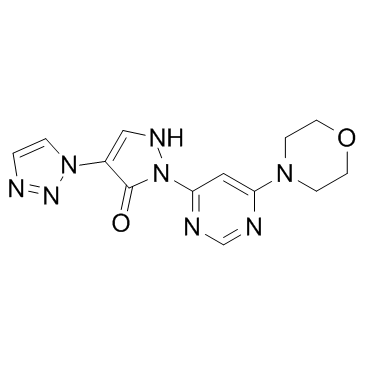Molidustat
Modify Date: 2024-01-02 13:32:29

Molidustat structure
|
Common Name | Molidustat | ||
|---|---|---|---|---|
| CAS Number | 1154028-82-6 | Molecular Weight | 314.303 | |
| Density | 1.7±0.1 g/cm3 | Boiling Point | 589.2±60.0 °C at 760 mmHg | |
| Molecular Formula | C13H14N8O2 | Melting Point | N/A | |
| MSDS | N/A | Flash Point | 310.2±32.9 °C | |
Use of MolidustatMolidustat (BAY 85-3934) is a novel inhibitor of hypoxia-inducible factor prolyl hydroxylase (HIF-PH) with mean IC50 values of 480 nM for PHD1, 280 nM for PHD2, and 450 nM for PHD3. |
| Name | 2-(6-morpholin-4-ylpyrimidin-4-yl)-4-(triazol-1-yl)-1H-pyrazol-3-one |
|---|---|
| Synonym | More Synonyms |
| Description | Molidustat (BAY 85-3934) is a novel inhibitor of hypoxia-inducible factor prolyl hydroxylase (HIF-PH) with mean IC50 values of 480 nM for PHD1, 280 nM for PHD2, and 450 nM for PHD3. |
|---|---|
| Related Catalog | |
| Target |
IC50: 480 nM (PHD1), 280 nM (PHD2), 450 nM (PHD3)[1] |
| In Vitro | The mean IC50 values of BAY 85-3934 for PHD1, PHD2, and PHD3 are 480 nM, 280 nM, and 450 nM, respectively. Exposure of HeLa cells to 5 μM BAY 85-3934 for 20 min is sufficient to induce detectable concentrations of HIF-1α. In a cellular reporter assay, BAY 85-3934 induces the expression of the firefly luciferase reporter gene under the control of a hypoxia responsive element promoter at a mean (± SD) EC50 of 8.4±0.7 μM (n=4) [1]. |
| In Vivo | HIF stabilization by oral administration of the HIF-PH inhibitor BAY 85-3934 (molidustat) results in dose-dependent production of EPO in healthy Wistar rats and cynomolgus monkeys. Molidustat therapy is aldo effective in the treatment of renal anemia in rats with impaired kidney function and, unlike treatment with rhEPO, resulted in normalization of hypertensive blood pressure in a rat model of CKD[1]. |
| Animal Admin | Rats: BAY 85-3934 is prepared as a solution in ethanol:Solutol HS 15:water (10:20:70). In a repeat-dose, 26-day experiment, male Wistar rats (240–340 g in body weight) are administered vehicle or BAY 85-3934 at doses of 0.5 mg/kg, 1.25 mg/kg, 2.5 mg/kg, and 5 mg/kg. The efficacy of BAY 85-3934 (2.5 mg/kg, once-daily, oral) is also compared with that of rhEPO (25 IU/kg, 50 IU/kg, and 100 IU/kg, twice-weekly, s.c. injection). The time-course of induction of EPO mRNA expression and plasma EPO is determined at baseline and 0.5 h, 1 h, 2 h, 4 h, 6 h, and 8 h after oral administration of a single dose of BAY 85-3934 (5 mg/kg)[1]. Monkey: BAY 85-3934 is prepared as a solution in 0.5% tylose. Male and female cynomolgus monkeys (2.8–5.6 kg in body weight) are administered at doses of 0.5 mg/kg and 1.5 mg/kg at 0 h, 24 h, 48 h, 72 h, and 96 h. Blood samples are taken at 7 h, 31 h, 55 h, 79 h, 103 h, and 168 h. Erythropoietic parameters are also evaluated after a 2-week treatment period with s.c. administration of rhEPO (100 IU/kg twice weekly at days 1, 4, 8, and 11) and BAY 85-3934 (1.5 mg/kg) once daily[1]. |
| References |
| Density | 1.7±0.1 g/cm3 |
|---|---|
| Boiling Point | 589.2±60.0 °C at 760 mmHg |
| Molecular Formula | C13H14N8O2 |
| Molecular Weight | 314.303 |
| Flash Point | 310.2±32.9 °C |
| Exact Mass | 314.123962 |
| PSA | 106.75000 |
| LogP | -1.77 |
| Vapour Pressure | 0.0±1.7 mmHg at 25°C |
| Index of Refraction | 1.820 |
| Storage condition | -20℃ |
| UNII-9JH486CZ13 |
| BAY 85-3934 |
| 2-[6-(4-Morpholinyl)-4-pyrimidinyl]-4-(1H-1,2,3-triazol-1-yl)-1,2-dihydro-3H-pyrazol-3-one |
| 3H-Pyrazol-3-one, 1,2-dihydro-2-[6-(4-morpholinyl)-4-pyrimidinyl]-4-(1H-1,2,3-triazol-1-yl)- |
| BAY-85-3934 |
| Molidustat |
| BAY85-3934 |